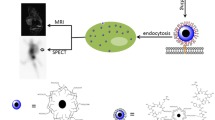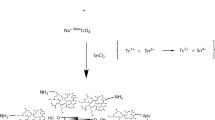Abstract
This work proposes a multifunctional diagnostic probe that is combined with magnetic resonance imaging (MRI) and single-photon emission computed tomography (SPECT) for imaging prostate cancer. For this purpose, 99mTc-radiolabeled bombesin-conjugated gadolinium nanoparticles ([99mTc]Tc-GdO@SiO-BBN-DFO) were synthesized. The average hydrodynamic diameter of the nanoconjugate was about 200 nm. The radiolabeling yield of [99mTc]Tc-GdO@SiO-BBN-DFO NPs was over 90%. In vitro studies were performed using healthy and cancerous prostate cells through the MTT test and apoptosis assay. In conclusion [99mTc]Tc-GdO@SiO-BBN-DFO NPs have the potential to be a novel multifunctional imaging SPECT/MRI probe and a promising bimodal imaging agent in the future.










Similar content being viewed by others
Abbreviations
- GdO-NPs:
-
Gadolinium oxide nanoparticles
- GdO-SiO:
-
Silica coated gadolinium oxide nanoparticles
- GdO-SiO-BBN:
-
Bombesin modified silica coated gadolinium oxide nanoparticles
- GdO-SiO-BBN-DFO:
-
Deferoxamine conjugated GdO-SiO-BBN nanoparticles
- [99mTc]Tc-GdO-SiO-BBN-DFO:
-
Radiolabeled-Nanoconjugate (99mTc-GdO-SiO-BBN-DFO)
- [99mTc]Tc -GdO-SiO-BBN:
-
Radiolabeled-Nanoconjugate (99mTc-GdO-SiO-BBN)
- [99mTc]Tc-DFO:
-
Radiolabeled-DFO
- NPs:
-
Nanoparticles
References
Ferlay J, Shin HR, Bray F et al (2010) Estimates of worldwide burden of cancer in 2008: GLOBOCAN 2008. Int J Cancer 127:2893–2917. https://doi.org/10.1002/ijc.25516
Dahlbom M, King MA (2017). In: Dahlbom M (ed) Imaging in medical diagnosis and therapy, In: physics of SPECT and PET imaging (28), 1st edn. CRC Press, Boca Raton
Jeong Kim T, Seok Chae K, Chang Y et al (2013) Gadolinium oxide nanoparticles as potential multimodal imaging and therapeutic agents. Curr Top Med Chem 13:422–433
Moreno P, Ramos-Álvarez I, Moody TW et al (2016) Bombesin related peptides/receptors and their promising therapeutic roles in cancer imaging, targeting and treatment. Exp Opin Ther Targets 20:1055–1073. https://doi.org/10.1517/14728222.2016.1164694
Cui D, Lu X, Yan C et al (2017) Gastrin-releasing peptide receptor-targeted gadolinium oxide-based multifunctional nanoparticles for dual magnetic resonance/fluorescent molecular imaging of prostate cancer. Int J Nanomed 12:6787–6797. https://doi.org/10.2147/IJN.S139246
Stefanakis D, Ghanotakis D (2014) Synthesis and characterization of nanoparticles, consisting of a gadolinium paramagnetic core and a mesoporous silica shell, for controlled delivery of hydrophobic drugs. J Nanoparticle Res 16:1–10. https://doi.org/10.1007/s11051-013-2211-3
Philipse AP, Van Bruggen MPB, Pathmamanoharan C (1994) Magnetic silica dispersions: preparation and stability of surface-modified silica particles with a magnetic core. Langmuir 10:92–99. https://doi.org/10.1021/la00013a014
Bethell GS, Ayers JS, Hancock WS et al (1979) A novel method of activation of cross-linked agaroses with 1,1’-carbonyldiimidazole which gives a matrix for affinity chromatography devoid of additional charged groups. J Biol Chem 254:2572–2574. https://doi.org/10.1016/s0021-9258(17)30106-0
Khan SA, Gambhir S, Ahmad A (2014) Extracellular biosynthesis of gadolinium oxide (Gd2O3) nanoparticles, their biodistribution and bioconjugation with the chemically modified anticancer drug taxol. Beilstein J Nanotechnol 5:249–257. https://doi.org/10.3762/bjnano.5.27
Tutun E, Tekin V, Yasakcı V et al (2021) Synthesis and morphological studies of Tc-99m-labeled lupulone-conjugated Fe3O4@TiO2 nanocomposite, and in vitro cytotoxicity activity on prostate cancer cell lines. Appl Organomet Chem 35:1–17. https://doi.org/10.1002/aoc.6435
Torabi M, Yaghoobi F, Karimi Shervedani R et al (2022) Mn(II) and Gd(III) deferrioxamine complex contrast agents and temozolomide cancer prodrug immobilized on folic acid targeted graphene/polyacrylic acid nanocarrier: MRI efficiency, drug stability and interactions with cancer cells. Colloids Surf A Physicochem Eng Asp 652:129797. https://doi.org/10.1016/j.colsurfa.2022.129797
Cheng Z, Thorek DLJ, Tsourkas A (2010) Gadolinium-conjugated dendrimer nanoclusters as a tumor-targeted T1 magnetic resonance imaging contrast agent. Angew Chemie 122:356–360. https://doi.org/10.1002/ange.200905133
Azizian G, Riyahi-alam N, Haghgoo S et al (2012) Synthesis route and three different core-shell impacts on magnetic characterization of gadolinium oxide-based nanoparticles as new contrast agents for molecular magnetic resonance imaging. Nanoscale Res Lett 7:1–10. https://doi.org/10.1186/1556-276X-7-549
Sadeghzadeh N, Ahmadzadeh M, Erfani M (2013) Evaluation of a new radiolabeled bombesin derivative with 99mTc as potential targeted tumor imaging agent. J Radioanal Nucl Chem 298:287–293. https://doi.org/10.1007/s10967-013-2464-4
Kumbhar AG, Narasimhan SV, Mathur PK (1998) Spectrophotometric method for determination parts per million levels of cyclohexylamine in water. Talanta 47:421–437. https://doi.org/10.1016/s0039-9140(98)00152-0
Chauhan D, Sri S, Kumar R et al (2021) Assessment of cytotoxicity profile of gadolinium oxide nanorods and the analogous surface-functionalized nanorods. Nano Futur 5:045001
Taylor KML, Kim JS, Rieter WJ et al (2008) Mesoporous silica nanospheres as highly efficient MRI contrast agents. J Am Chem Soc 130:2154–2155. https://doi.org/10.1021/ja710193c
Li T, Duan EY, Liu CJ et al (2018) Application of Gd(III) complexes for magnetic resonance imaging and the improvement of relaxivities via nanocrystallization. Inorg Chem Commun 98:111–114. https://doi.org/10.1016/j.inoche.2018.10.012
Cao T, Zhou X, Zheng Y et al (2017) Chelator-free conjugation of 99mTc and Gd3+ to PEGylated nanographene oxide for dual-modality SPECT/MR imaging of Lymph nodes. ACS Appl Mater Interfaces 9:612–42621. https://doi.org/10.1021/acsami.7b14836
Kobayashi Y, Shibuya K, Nakagawa T, Kubota Y, Gonda K, Ohuchi N (2015) Direct immobilization of gadolinium complex on silica particles and their MRI properties. e-J Surf Sci Nanotech 13(0):42–46. https://doi.org/10.1380/ejssnt.2015.42
Narmani A, Farhood B, Haghi-Aminjan H et al (2018) Gadolinium nanoparticles as diagnostic and therapeutic agents: their delivery systems in magnetic resonance imaging and neutron capture therapy. J Drug Deliv Sci Technol 44:457–466. https://doi.org/10.1016/j.jddst.2018.01.011
Abraham JL, Thakral C, Skov L et al (2008) Dermal inorganic gadolinium concentrations: evidence for in vivo transmetallation and long-term persistence in nephrogenic systemic fibrosis. Br J Dermatol 158:273–280. https://doi.org/10.1111/j.1365-2133.2007.08335.x
Challa R, Ahuja A, Ali J et al (2005) Cyclodextrins in drug delivery: an updated review. AAPS PharmSciTech 6:329–357. https://doi.org/10.1208/pt060243
Anishur Rahman ATM, Vasilev K, Majewski P (2011) Ultra small Gd2O3 nanoparticles: absorption and emission properties. J Colloid Interface Sci 354:592–596. https://doi.org/10.1016/j.jcis.2010.11.012
McDonald MA, Watkin KL (2003) Small particulate gadolinium oxide and gadolinium oxide albumin microspheres as multimodal contrast and therapeutic agents. Invest Radiol 38:305–310. https://doi.org/10.1097/01.rli.0000067487.84243.91
Mortezazadeh T, Gholibegloo E, Alam NR et al (2019) Gadolinium (III) oxide nanoparticles coated with folic acid-functionalized poly (β-cyclodextrin-co-pentetic acid) as a biocompatible targeted nano-contrast agent for cancer diagnostic: in vitro and in vivo studies. Magn Reson Mater Phys Biol Med 32:487–500. https://doi.org/10.1007/s10334-019-00738-2
Gao H, Liu X, Tang W et al (2016) 99mTc-conjugated manganese-based mesoporous silica nanoparticles for SPECT, pH-responsive MRI and anti-cancer drug delivery. Nanoscale 8:19573–19580. https://doi.org/10.1039/C6NR07062K
Acknowledgements
Authors thank Dr. Halil İbrahim Özdemir for MRI imaging of nanoconjugates in Ege University Radiology Department and Kadriye Buşra Karatay for assistance with HPLC analyses. The work paper presented as poster at International Nuclear Sciences and Technologies Conference (INSTEC-22, 19-22 October 2022).
Author information
Authors and Affiliations
Corresponding author
Ethics declarations
Conflict of interest
The authors declare no conflict of interest.
Additional information
Publisher's Note
Springer Nature remains neutral with regard to jurisdictional claims in published maps and institutional affiliations.
Rights and permissions
Springer Nature or its licensor (e.g. a society or other partner) holds exclusive rights to this article under a publishing agreement with the author(s) or other rightsholder(s); author self-archiving of the accepted manuscript version of this article is solely governed by the terms of such publishing agreement and applicable law.
About this article
Cite this article
Akkaya, T.S., Tutun, E., Yasakçı, V. et al. Synthesis, radiolabeling, and investigation of bombesin-modified gadolinium nanoparticles as a potential SPECT/MRI agent for prostate cancer. J Radioanal Nucl Chem 332, 4755–4766 (2023). https://doi.org/10.1007/s10967-023-08965-7
Received:
Accepted:
Published:
Issue Date:
DOI: https://doi.org/10.1007/s10967-023-08965-7




